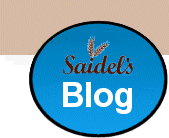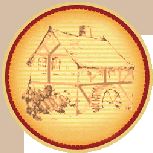by Les Saidel - October, 2011
Bread is highly ingrained in Jewish culture and a prominent feature both at everyday meals and on religious occasions. Bread is mentioned numerous times in scripture and in the writings of the sages, being recognized both as a staple of the diet but also elevated to a higher plane, such as in the Face Bread Offering in the ancient Temple.
As the Jewish People have wandered over the centuries, they have garnered nuances from other cultures and incorporated them into their own breads.
In this article I will explore some distinctly Jewish breads, their origins, the legends surrounding them and dispel some myths that have become associated with them.
Perhaps the earliest, distinctly Jewish bread was Matzo. This unleavened bread originated in ancient Egypt during the time when the Jews were enslaved there (around 1312 BCE). The Bible relates in great detail the Exodus from Egypt, the 10 plagues and how the Israelites had to urgently leave before their bread had time to rise, resulting in the unleavened bread we know as Matzo. This bread is eaten traditionally on the Jewish festival of Passover in memory of that hasty exit from Egypt.
Unleavened bread subsequently assumed religious significance in Jewish culture, symbolizing the spiritual essence, as opposed to the inflated materialism of leavened bread. Nowhere was this more prominent than in the ancient Temple and the holy Face Bread Offering. This unleavened bread, baked in rectangular shaped pans, miraculously remained, as legend has it, warm and fresh for an entire week.
Preparation of this bread was an art and a highly guarded secret preserved by the Garmo family, the Levites responsible for its production. According to tradition, at one point this family capitalized on their monopoly in the Face Bread market, charging exorbitant fees and forcing the sages to seek an alternative. As the story has it, the replacement bakers failed repeatedly to duplicate the quality required and the sages were forced to return to the Garmo family and pay the price demanded.
After the destruction of the Temples and the dispersion of the Jewish people in the Diaspora, bread still retained its spiritual connotations, none more notable than the Challah, a braided loaf eaten on the Sabbath.
Many theories have been expounded as to the origins of the braided form of this bread and its symbolism. The prevalent consensus is that the intertwining of the braids symbolizes love and fertility - in its physical form, the love between man and wife and in spiritual form, the love between man and G-d. Hence the custom of eating it on the holiest day of the week, the Sabbath and on the festivals.
Challahs also assumed diverse shapes according to which festival they were eaten on, the most famous being a round shape on the Jewish New Year. The true reason for the round shape is not clear. Supposedly it is meant to symbolize the circle of life, but one cannot discount the little known baker's wisdom that New Year challahs were shaped round simply because it was quicker than a conventional braid and the workload for the New Year necessitated speedier production. It is unclear if the round shape originated from the symbolism or the bakers need to meet production demands. Perhaps it was a little of both.
Another interesting challah is the Key Challah. Some braid this challah in the shape of a key and others actually bake a real key inside the dough. It is eaten on the first Sabbath following Passover and is supposed to be a good omen, providing one with a plentiful income during the year.
Some East European communities bake a flower shaped challah on the festival of Purim to symbolize "Shoshanat Yaakov", (Rose of Jacob) - a poem sung after the reading of Megilat Esther.
Another famous Purim challah is baked by Moroccan Jewry and is called Haman's Eyes. The eyes are unpeeled, hard boiled eggs which are sunken in the dough, resembling something like a pair of Elton John's spectacles.
Actually most Mizrahi (Eastern) Jewry never knew about braided challahs until they became integrated into modern Israeli society. Their form of bread more closely resembled flat pita bread (much like the bread of the Middle Eastern countries of their birth). They, like Ashkenazi Jewry, enjoyed rich symbolism in their breads, for instance by using twelve pita breads on the Sabbath, arranged in a fashion similar to the Face Bread in the ancient Temple.
Besides challah, perhaps no other bread is more typically Jewish than the Bagel.
Legend has it that the bagel was invented as a tribute to King Jan III of Poland for his victory over the Turks in the Battle of Vienna in 1683. The bakers supposedly created a stirrup shaped bread to celebrate the occasion. The Austrian/German word for stirrup is 'beugel'.
This legend is unlikely however, since as early as 1610 we have written documentation of the word 'bagel' - in the bylaws of the Jewish community of Krakow, Poland. There it is written that it was customary to give a woman in childbirth a bagel as a gift, the round form of the bread supposedly symbolizing the circle of life. Bagels were also traditionally served in a house of bereavement for the same reason.
It is now commonly accepted that the bagel was invented by the Jewish community of Poland in the early 1600's to compete with the 'bublik', a Christian bread traditionally eaten on Lent. It went on to become a staple of Polish cuisine. It is likely that the name originated from the German word for stirrup, 'beugel', that described its shape.
Bagels did not assume global proportions until they were brought into the USA by East European immigrants in the early 1900's and have since become an American byword, eaten with cream cheese and lox.
Yet another East European bread, the Bialy, originated at around the same time as the bagel in Bialystok, Poland. Bialystoker Kuechen, or Bialys for short, were round like bagels, but had no hole in the center. Instead they had a central indentation filled with mashed onion. Like bagel they found their way to America and are well known, especially in New York.
It has been a few hundred years since the Jewish People have invented a bread that has conquered the world like challah and bagels.
Perhaps in a few hundred years time (hopefully sooner), our Rambam Bread might take the world by storm and become the next Jewish contribution to world bread. Meanwhile you will have to obtain it exclusively from Saidels Bakery.
We just wanted it down in writing, so that Wikipedia in 200 years (or its equivalent) will have no problem tracing it to its source :)
Les Saidel
© Copyright. All rights in the above articles are reserved to the author Les Saidel.
No part of this website or the above articles may be transmitted in any form or by any
means without permission in writing from the author.




